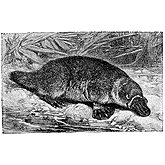Nature's Exceptions to Our Rules
 We all learned in grade school that animals are classified into different categories: Mammals have fur, are warm blooded, give birth to their young and feed their babies milk. Birds have feathers, lay eggs and don't have teeth. Reptiles are cold blooded and lay eggs. Fish have gills and are cold blooded. Seems pretty simple, right?
We all learned in grade school that animals are classified into different categories: Mammals have fur, are warm blooded, give birth to their young and feed their babies milk. Birds have feathers, lay eggs and don't have teeth. Reptiles are cold blooded and lay eggs. Fish have gills and are cold blooded. Seems pretty simple, right?
Well, when you actually go out and look at all of the different animals out there, things get pretty complicated. For example, in what category do you put the platypus? A platypus has a duck-shaped bill that is made of soft leathery skin. It has fur, lays eggs, and has webbed feet. When the young are hatched, milk oozes out if the skin of the mother for the young to eat. The male platypus has one half inch long spurs on each hind leg connected to venom glands. The venom is strong enough to kill a dog. If that isn't enough, consider the echidna or spiny anteater. This animal has a long pointy snout and a sticky tongue to eat ants similar to an anteater, has spiny fur like a porcupine, and develops a pouch for it's young to live in after it's eggs hatch! With all of these anomalies, they both are still considered mammals, and belong to the same sub family called the Monotrens. They are the only animals in this sub family.
Scientists like to categorize all living things, but there always seems to be exceptions to the rule. The platypus and echidna seem to fall into almost all categories, but were defined as mammals because they have fur, are warm blooded and lactate milk.
About the Author
Willa Larsen, MS
 Willa Larsen writes on a wide array of topics for ScienceIQ. Willa
received a BS in physics from University of Colorado and a MS in
materials science and engineering from UCLA. She previously worked
making infrared detectors for the Hubble, missiles and surveillance
equipment. Willia is the publisher of WillasArk.com which helps fund animal rescue.
Willa Larsen writes on a wide array of topics for ScienceIQ. Willa
received a BS in physics from University of Colorado and a MS in
materials science and engineering from UCLA. She previously worked
making infrared detectors for the Hubble, missiles and surveillance
equipment. Willia is the publisher of WillasArk.com which helps fund animal rescue.


